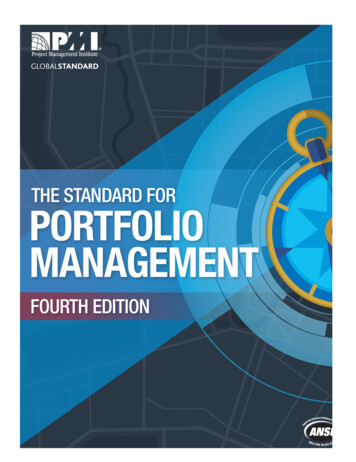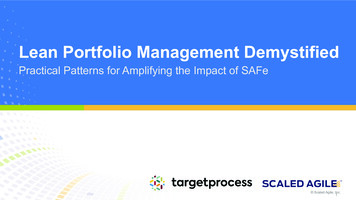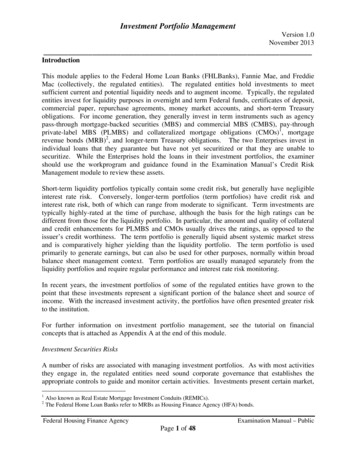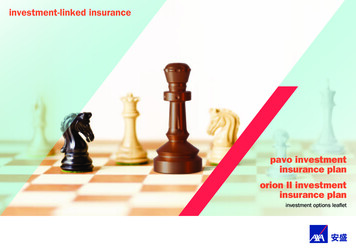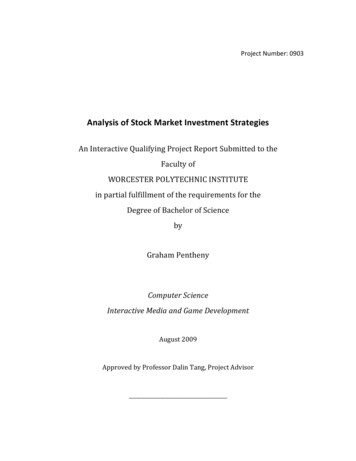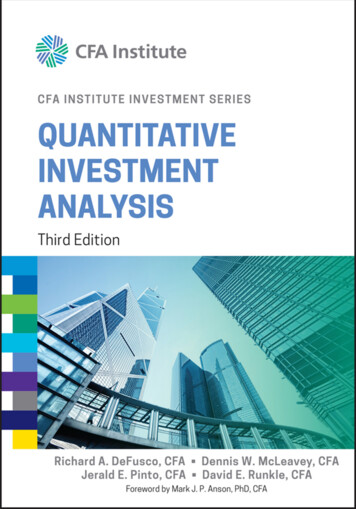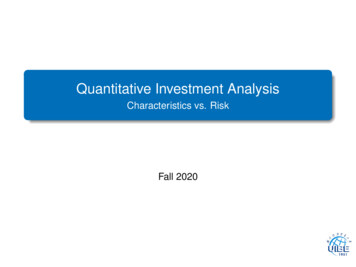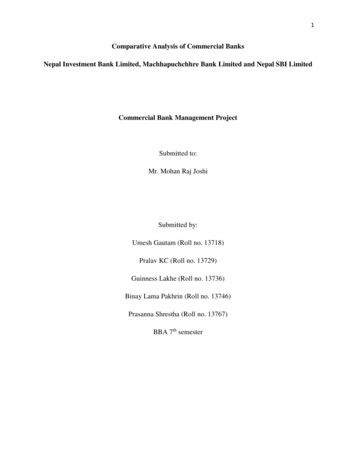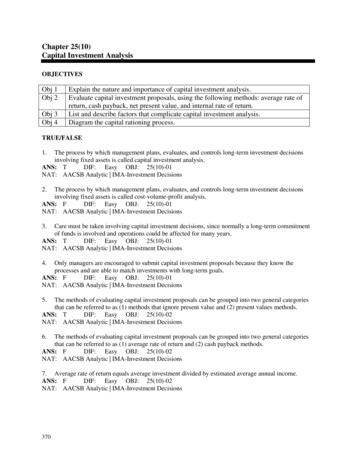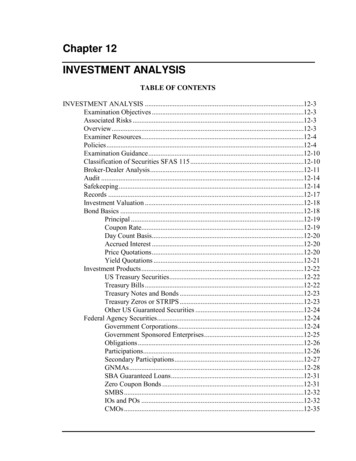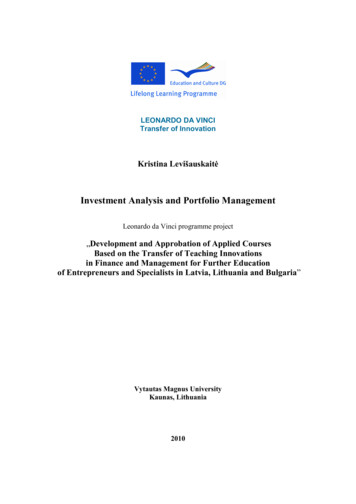
Transcription
LEONARDO DA VINCITransfer of InnovationKristina Levišauskait Investment Analysis and Portfolio ManagementLeonardo da Vinci programme project„Development and Approbation of Applied CoursesBased on the Transfer of Teaching Innovationsin Finance and Management for Further Educationof Entrepreneurs and Specialists in Latvia, Lithuania and Bulgaria”Vytautas Magnus UniversityKaunas, Lithuania2010
Investment Analysis and Portfolio ManagementTable of ContentsIntroduction .41. Investment environment and investment management process .71.1 Investing versus financing 71.2. Direct versus indirect investment .91.3. Investment environment .111.3.1. Investment vehicles .111.3.2. Financial markets .191.4. Investment management process .23Summary .26Key-terms 28Questions and problems .29References and further readings .30Relevant websites 312. Quantitative methods of investment analysis .322.1. Investment income and risk .322.1.1. Return on investment and expected rate of return .322.1.2. Investment risk. Variance and standard deviation .352.2. Relationship between risk and return .362.2.1. Covariance 362.2.2. Correlation and Coefficient of determination .402.3. Relationship between the returns on stock and market portfolio 422.3.1. Characteristic line and Beta factor .432.3.2. Residual variance .44Summary .45Key-terms .48Questions and problems .48References and further readings .503. Theory for investment portfolio formation .513.1. Portfolio theory 513.1.1. Markowitz portfolio theory .513.1.2. The expected rate of return and risk of portfolio .543.2. Capital Asset Pricing Model 563.3. Arbitrage Price Theory 593.4. Market Efficiency Theory 62Summary .64Key-terms .66Questions and problems 67References and further readings .704. Investment in stocks .714.1. Stock as specific investment .714.2. Stock analysis for investment decision making 724.2.1. E-I-C analysis .734.2.2. Fundamental analysis .754.3. Decision making of investment in stocks. Stock valuation .774.4. Formation of stock portfolios .824.5. Strategies for investing in stocks .84Summary .87Key-terms 902
Investment Analysis and Portfolio ManagementQuestions and problems .90References and further readings .93Relevant websites .935. Investment in bonds .945.1. Identification and classification of bonds 945.2. Bond analysis: structure and contents .985.2.1. Quantitative analysis .985.2.2. Qualitative analysis .1015.2.3. Market interest rates analysis .1035.3. Decision making for investment in bonds. Bond valuation .1065.4. Strategies for investing in bonds. Immunization .109Summary 113Key-terms .116Questions and problems .117References and further readings . 118Relevant websites .1196. Psychological aspects in investment decision making .1206.1. Overconfidence .1206.2. Disposition effect .1236.3. Perceptions of investment risk .1246.4. Mental accounting and investing .1266.5. Emotions and investment decisions .128Summary .130Key-terms .132Questions and problems .132References and further readings 1337. Using options as investments .1357.1. Essentials of options .1357.2. Options pricing .1367.3. Using options. Profit and loss on options .1387.4. Portfolio protection with options. Hedging .141Summary 143Key-tems 145Questions and problems .146References and further readings 147Relevant websites .1478. Portfolio management and evaluation .1488.1. Active versus passive portfolio management 1488.2. Strategic versus tactical asset allocation 1508.3. Monitoring and revision of the portfolio .1528.4. Portfolio performance measures 154Summary 156Key-terms .158Questions and problems .158References and further readings 160Relevant websites .161Abbreviations and symbols used .162Bibliography 164Annexes .1653
Investment Analysis and Portfolio ManagementIntroductionMotivation for Developing the CourseResearch by the members of the project consortium Employers’ Confederationof Latvia and Bulgarian Chamber of Commerce and Industry indicated the need forfurther education courses.Innovative Content of the CourseThe course is developed to include the following innovative content: Key concepts of investment analysis and portfolio management which individualinvestors‘decision making issues. Applied exercises and problems, which cover major topics such as quantitativemethods of investment analysis and portfolio formation, stocks and bondsanalysis and valuation for investment decision making, options pricing andusing as investments, asset allocation, portfolio rebalancing, and portfolioperformance measures. Summaries, Key-terms, Questions and problems are provided at the end ofevery chapter, which aid revision and control of knowledge acquisition duringself-study; References for further readings and relevant websites for broadeningknowledge and analyzing real investment environment are presented at the endof every chapter.Innovative Teaching Methods of the CourseThe course is developed to utilize the following innovative teaching methods: Availability on the electronic platform with interactive learning and interactiveevaluation methods; Active use of case studies and participant centered learning; Availability in modular form; Utilizing two forms of learning - self-study and tutorial consultations; Availability in several languages simultaneously.Target Audience for the CourseThe target audience is: entrepreneurs, finance and management specialists fromLatvia, Lithuania and Bulgaria.4
Investment Analysis and Portfolio ManagementThe course assumes little prior applied knowledge in the area of finance.The course is intended for 32 academic hours (2 credit points).Course ObjectivesInvestment analysis and portfolio management course objective is to helpentrepreneurs and practitioners to understand the investments field as it is currentlyunderstood and practiced for sound investment decisions making. Following thisobjective, key concepts are presented to provide an appreciation of the theory andpractice of investments, focusing on investment portfolio formation and managementissues. This course is designed to emphasize both theoretical and analytical aspects ofinvestment decisions and deals with modern investment theoretical concepts andinstruments. Both descriptive and quantitative materials on investing are presented.Upon completion of this course the entrepreneurs shall be able: to describe and to analyze the investment environment, different types ofinvestment vehicles; to understand and to explain the logic of investment process and thecontents of its’ each stage; to use the quantitative methods for investment decision making – tocalculate risk and expected return of various investment tools and theinvestment portfolio; to distinguish concepts of portfolio theory and apply its’ principals in theprocess of investment portfolio formation; to analyze and to evaluate relevance of stocks, bonds, options for theinvestments; to understand the psychological issues in investment decision making; to know active and passive investment strategies and to apply them inpractice.The structure of the courseThe Course is structured in 8 chapters, covering both theoretical and analyticalaspects of investment decisions:1. Investment environment and investment process;2. Quantitative methods of investment analysis;3. Theory of investment portfolio formation;4. Investment in stocks;5
Investment Analysis and Portfolio Management5. Investment in bonds;6. Psychological aspects in investment decision making;7. Using options as investments;8. Portfolio management and evaluation.Evaluation MethodsAs has been mentioned before, every chapter of the course containsopportunities to test the knowledge of the audience, which are in the form of questionsand more involved problems. The types of question include open ended questions aswell as multiple choice questions. The problems usually involve calculations usingquantitative tools of investment analysis, analysis of various types of securities,finding and discussing the alternatives for investment decision making.Summary for the CourseThe course provides the target audience with a broad knowledge on the keytopics of investment analysis and management. Course emphasizes both theoreticaland analytical aspects of investment decision making, analysis and evaluation ofdifferent corporate securities as investments, portfolio diversification and management.Special attention is given to the formulation of investment policy and strategy.The course can be combined with other further professional education coursesdeveloped in the project.6
Investment Analysis and Portfolio Management1. Investment environment and investment management processMini-contents1.1. Investing versus financing1.2. Direct versus indirect investment1.3. Investment environment1.3.1. Investment vehicles1.3.2. Financial markets1.4. Investment management processSummaryKey termsQuestions and problemsReferences and further readingsRelevant websites1.1. Investing versus financingThe term ‘investing” could be associated with the different activities, but thecommon target in these activities is to “employ” the money (funds) during the timeperiod seeking to enhance the investor’s wealth. Funds to be invested come fromassets already owned, borrowed money and savings. By foregoing consumption todayand investing their savings, investors expect to enhance their future consumptionpossibilities by increasing their wealth.But it is useful to make a distinction between real and financial investments.Real investments generally involve some kind of tangible asset, such as land,machinery, factories, etc. Financial investments involve contracts in paper orelectronic form such as stocks, bonds, etc. Following the objective as it presented inthe introduction this course deals only with the financial investments because the keytheoretical investment concepts and portfolio theory are based on these investmentsand allow to analyze investment process and investment management decision makingin the substantially broader contextSome information presented in some chapters of this material developed forthe investments course could be familiar for those who have studied other courses infinance, particularly corporate finance. Corporate finance typically covers such issuesas capital structure, short-term and long-term financing, project analysis, current assetmanagement. Capital structure addresses the question of what type of long-termfinancing is the best for the company under current and forecasted market conditions;project analysis is concerned with the determining whether a project should beundertaken. Current assets and current liabilities management addresses how to7
Investment Analysis and Portfolio Managementmanage the day-by-day cash flows of the firm. Corporate finance is also concernedwith how to allocate the profit of the firm among shareholders (through the dividendpayments), the government (through tax payments) and the firm itself (throughretained earnings). But one of the most important questions for the company isfinancing. Modern firms raise money by issuing stocks and bonds. These securities aretraded in the financial markets and the investors have possibility to buy or to sellsecurities issued by the companies. Thus, the investors and companies, searching forfinancing, realize their interest in the same place – in financial markets. Corporatefinance area of studies and practice involves the interaction between firms andfinancial markets and Investments area of studies and practice involves the interactionbetween investors and financial markets. Investments field also differ from thecorporate finance in using the relevant methods for research and decision making.Investment problems in many cases allow for a quantitative analysis and modelingapproach and the qualitative methods together with quantitative methods are moreoften used analyzing corporate finance problems. The other very important differenceis, that investment analysis for decision making can be b
quantitative tools of investment analysis, analysis of various types of securities, finding and discussing the alternatives for investment decision making. Summary for the Course The course provides the target audience with a broad knowledge on the key topics of investment analysis and management. Course emphasizes both theoretical and analytical aspects of investment decision making, analysis .File Size: 1MBPage Count: 166
